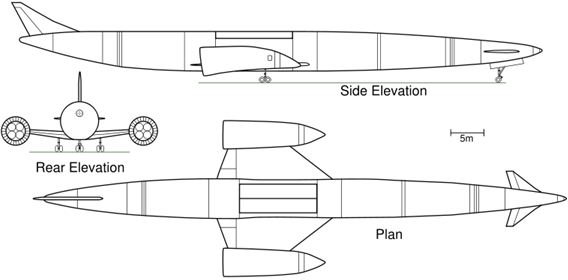Skylon and SABRE - An Unbeatable Combination to Get Into Orbit?
Since the dawn of manned spaceflight, humans have looked forward to a day when access to space became as routine as a drive to the store. Many attempts have been made, most notably, NASA’s National Aero Space Plane, DC-X, and X-33 Venture Star, but to date, no program has yet accomplished this task. If Reaction Motors, a British company, has its way, however, this will not be true for long. If successful, the Skylon vehicle promises to change that forever.
To date, all space vehicles have been classified by the number of stages included in their designs. For instance, the Shuttle’s design could be considered a two and a half stage concept, since only two of the three components actually provide thrust. The issue with all such staged designs is that, either the stages have to be designed to be returned to earth in some fashion, or they have to be considered disposable. Obviously, disposable stages increase the long-term cost of the program and, in the case of rockets, subject the crew to higher acceleration loads. On the other hand, building a single stage vehicle is extremely challenging, given fuel requirements and the limitations of rocket motors.
One of the major concerns in vehicle design is the issue of weight; since a rocket cannot provide its own oxidizer, it is required to bring it along, which adds to weight and decreases payload. To circumvent this issue, designs have been proposed which use air breathing engines for the initial acceleration and use rockets only for entering orbit. While this idea sounds good on paper (after all, it decreases vehicle mass by eliminating the oxidizer requirement), accomplishing it is far more difficult. Since no engines exist which operate in the entire speed regime between zero and Mach 25, a single stage to orbit air breathing design is required to use multiple types of engines, which both increases complexity and mass. Scramjets are capable of extremely high operating velocities, however, since they do not slow in coming air below mach one, igniting one and keeping it lit is challenging, to say the very least.
Enter Reaction Motors’ design, one that has the very considerable virtue of being simple. Instead of relying on complicated engines, the Skylon’s propulsion system is basically what is referred to as a ducted rocket. At speeds below Mach 5.5, the SABRE engine operates in a manner similar to the Lockheed SR-71’s “turbo-ramjet”, with the main difference being the active cooling of the inlet spike. Above this speed, the spike closes and operates as a rocket.
While the propulsion system certainly stands out, it is not the only noteworthy thing about this craft- Part 2 will elaborate further on the distinctive aspects of this intriguing vehicle.
This post is part of the series: Skylon- A Tale Of A British Aero-Space Plane
Sometimes, good ideas don’t die- they manage to be refined until they become a workable, finished product. Reaction Engines’ Skylon may prove to be one more good idea whose time will eventually come.
